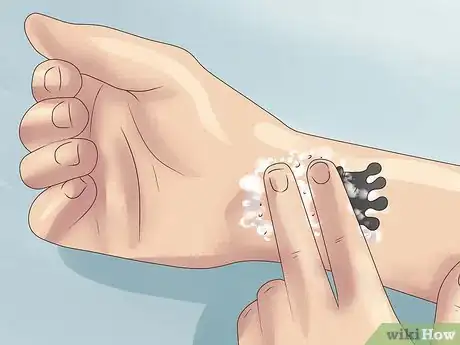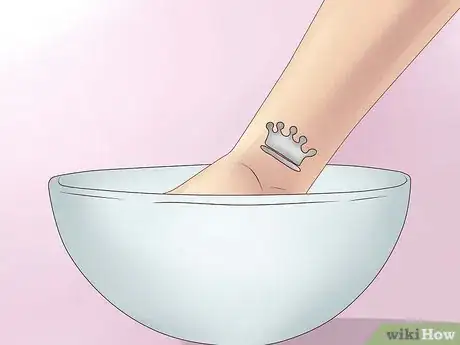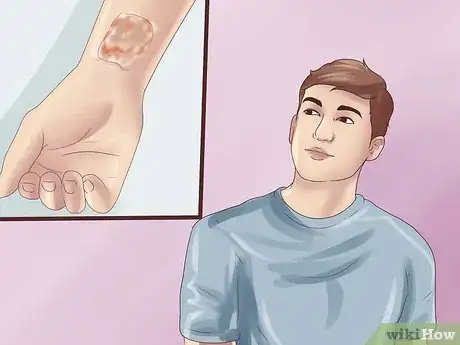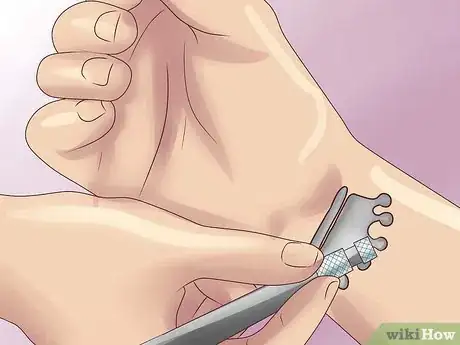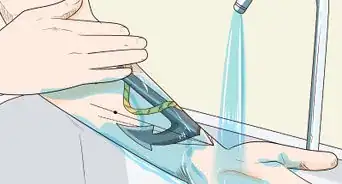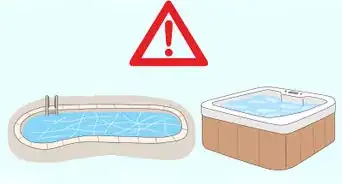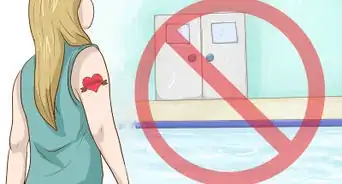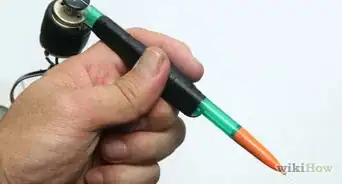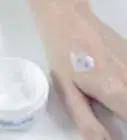wikiHow is a “wiki,” similar to Wikipedia, which means that many of our articles are co-written by multiple authors. To create this article, 48 people, some anonymous, worked to edit and improve it over time.
There are 7 references cited in this article, which can be found at the bottom of the page.
This article has been viewed 1,247,235 times.
Learn more...
Do you have buyer's remorse on your tattoo? As tattoos have become big business, the amount of people who regret their ink has risen dramatically. New procedures now exist for removing unwanted tattoos, many of them remarkably successful. Unfortunately, many DIY home remedies have also sprung up, many of them unsafe or ineffective. Here's what you'll want to know about using salt on tattoos, along with other helpful information on removing your unwanted tattoo.
Steps
Knowing What Not to Do
-
1Be very careful about rubbing salt into your tattoo. Whether you've just gotten your tattoo or have had it for longer than you'd like, using salt to remove a tattoo is a dangerous proposition. Here's why:[1]
- Your skin has effectively two layers — the dermis, or inner part of the skin, and the epidermis, or outer layer of your skin. When you get a tattoo, the ink travels past the epidermis, or superficial layer of skin, and into the dermis. Rubbing salt onto the epidermis is easy but useless. You need to get the salt into the dermis; even if you did manage to rub away the top layer of your skin to get at the ink, it's probably not going to end well.
- Rubbing your tattoo with salt will give you a pretty nasty road rash. It may also cause pigmentation of the skin, wrinkling, and possibly scarring. Know that doing this procedure at home can have significant adverse consequences, and may make your tattoo look even worse.[2]
-
2Know why this myth started. Although there is a dermatological procedure that uses salt as a slight abrasive, there is probably one glaring reason why salt is thought to be a good tattoo eraser. When you get a tattoo, you're told not to submerge your tattoo in water, especially in salt water. If you're not supposed to soak your tattoo in salt water if you want to keep it, maybe you could soak your tattoo in salt water if you didn't? That's the reasoning at least.
- Soaking your tattoo in salt water, in fact, will only cause the ink to disperse, run, or possibly fade. It won't cause your tattoo to magically vanish. It's likely your tattoo will look worse after you soak it in salt water if your tattoo is newly inked. If you've had your tattoo for several weeks or longer, it's likely that submerging your tattoo in salt water will have no effect.
Advertisement -
3Know that procedures that use salt as an abrasive do exist. Trying DIY salt abrasion, also called salabrasion, is probably not the best idea. As mentioned earlier, you're likely to hurt yourself and do more harm than good. But there are professional procedures out there that use salabrasion, and some of them can be promising.[3]
- According to a German study in the National Institute of Health database, salabrasion had "perfectly acceptable to good results" in tattoo removal.[4] In this study, wrinkling did occur, but not scar formation.
- In one salabrasion procedure, a topical anesthetic is applied to the top of the tattoo. An ink gun-like device used a saline solution to effectively puncture the dermis and draw ink up instead of deposit ink in the skin. Effectively this is like getting a tattoo in reverse. The procedure heals in 6 to 8 weeks. Ask to see testimonials before agreeing to the procedure.
Considering Other Options
-
1Try laser tattoo removal. Laser tattoo removal is the safest and most effective means of eliminating an unwanted tattoo. Doctors or aestheticians shoot highly-concentrated pulses of light at the ink, which can help shatter the ink and lead to a remarkable reduction in visible ink.[5]
- Depending on the size of the tattoo, laser surgery will set you back anywhere from $100 to $1,000, making it one of the most cost-effective removal procedures on the market.
-
2Talk to an aesthetician about dermabrasion. This procedure is very similar to salabrasion in that it's administered under the supervision of trained professionals and sands down layers of skin to get at ink.[6]
- This method is a bit less pricey that laser treatment, costing about $1,000 to $2,000. This procedure tends to hurt as much as getting a tattoo, and the ink generally is more visible after a dermabrasion than it is after laser removal.
-
3Consider cryosurgery and chemical peels. With cryosurgery, the skin is frozen and the ink burned off with liquid nitrogen. Chemical peels cause the skin to blister and slough off, removing some of the tattoo ink. Neither is a horribly popular option, as they are both expensive and painful. If you are desperate however, they may be worth considering.[7]
-
4Talk with your doctor or aesthetician about surgery. Surgery is the final option. With a scalpel, a doctor will remove the skin of the tattoo and cinch old skin around it.[8] A new scar will form, and it may be painful, even if you are given a topical anesthetic.
Community Q&A
Did you know you can get answers researched by wikiHow Staff?
Unlock staff-researched answers by supporting wikiHow
-
QuestionDoes salt and lemon remove tattoos?
 wikiHow Staff EditorThis answer was written by one of our trained team of researchers who validated it for accuracy and comprehensiveness.
wikiHow Staff EditorThis answer was written by one of our trained team of researchers who validated it for accuracy and comprehensiveness.
Staff Answer wikiHow Staff EditorStaff AnswerWhile lemon juice can lighten skin, it only does so on the epidermis (your top layer of skin); tattoo pigments are below this layer and therefore the lemon cannot reach them. Rubbing salt into the dermis is likely to leave scarring (as well as being painful), as the epidermis needs to be removed. It is best to discuss options with a dermatologist and to consider laser treatment for effective and non-scarring tattoo removal.
wikiHow Staff EditorStaff AnswerWhile lemon juice can lighten skin, it only does so on the epidermis (your top layer of skin); tattoo pigments are below this layer and therefore the lemon cannot reach them. Rubbing salt into the dermis is likely to leave scarring (as well as being painful), as the epidermis needs to be removed. It is best to discuss options with a dermatologist and to consider laser treatment for effective and non-scarring tattoo removal. -
QuestionCan tattoo be removed?
 wikiHow Staff EditorThis answer was written by one of our trained team of researchers who validated it for accuracy and comprehensiveness.
wikiHow Staff EditorThis answer was written by one of our trained team of researchers who validated it for accuracy and comprehensiveness.
Staff Answer wikiHow Staff EditorStaff AnswerYes, tattoos can be removed but the success varies depending on the type of process used, the type of ink and colors, etc. It’s highly advisable to see a dermatologist to discuss your options but some possibilities for tattoo removal include: Laser removal using Q-switched lasers, dermabrasion, cryosurgery, chemical peels, surgery and even skin grafts. Some colors, such as greens and yellows, are harder to remove than black and dark colors. The most successful method is laser removal; note that all removal measures take time and are usually painful.
wikiHow Staff EditorStaff AnswerYes, tattoos can be removed but the success varies depending on the type of process used, the type of ink and colors, etc. It’s highly advisable to see a dermatologist to discuss your options but some possibilities for tattoo removal include: Laser removal using Q-switched lasers, dermabrasion, cryosurgery, chemical peels, surgery and even skin grafts. Some colors, such as greens and yellows, are harder to remove than black and dark colors. The most successful method is laser removal; note that all removal measures take time and are usually painful. -
QuestionDoes Salt Water fade tattoos?
 wikiHow Staff EditorThis answer was written by one of our trained team of researchers who validated it for accuracy and comprehensiveness.
wikiHow Staff EditorThis answer was written by one of our trained team of researchers who validated it for accuracy and comprehensiveness.
Staff Answer wikiHow Staff EditorStaff AnswerSaltwater may cause a newly inked tattoo to fade. It may also cause the ink of an early stage tattoo to run or disperse oddly. This is the reason for being asked to not put your skin in saltwater for a time after getting the tattoo. However, unless the ink’s dodgy, once the tattoo has set properly after a few weeks or so, saltwater usually has no effect on it.
wikiHow Staff EditorStaff AnswerSaltwater may cause a newly inked tattoo to fade. It may also cause the ink of an early stage tattoo to run or disperse oddly. This is the reason for being asked to not put your skin in saltwater for a time after getting the tattoo. However, unless the ink’s dodgy, once the tattoo has set properly after a few weeks or so, saltwater usually has no effect on it.
Warnings
- If you have heard of "The Salt Challenge" then you will know that the act of rubbing salt on your skin will cause you to feel like you are being burnt! Take 'extreme caution please!⧼thumbs_response⧽
- This approach can be dangerous and result in unwanted pain and scarring.⧼thumbs_response⧽
- Do not apply salt to open wounds.⧼thumbs_response⧽
References
- ↑ https://www.americanscientist.org/blog/macroscope/undoing-tattoos
- ↑ http://www.ncbi.nlm.nih.gov/pubmed/6845800
- ↑ https://www.tattoolapalooza.com/removing-a-tattoo-with-salabrasion/
- ↑ http://www.ncbi.nlm.nih.gov/pubmed/6845800
- ↑ http://edition.cnn.com/2010/HEALTH/06/11/remove.tattoo.health/index.html
- ↑ https://www.plasticsurgery.org/cosmetic-procedures/dermabrasion
- ↑ https://www.health.com/health/article/0,,20411992,00.html
- ↑ http://www.mayoclinic.com/health/tattoo-removal/MY01066/DSECTION=what-you-can-expect
About This Article
If you want to remove a tattoo at home with salt, you should be aware that this is a dangerous procedure that can be painful and probably won’t work. Rubbing salt into your skin can cause the ink to run or fade and can lead to scarring and infection. If you’re serious about getting your tattoo removed, consider laser surgery, which is the safest and most effective method. Alternatively, talk to a doctor about dermabrasion, which is a procedure that involves sanding down your skin to get to the ink. However, this can be very painful and won’t necessarily get rid of all the ink. For more tips, including how to get your tattoo removed with cryosurgery or chemical peels, read on!
